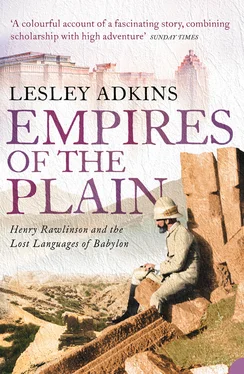1 ...7 8 9 11 12 13 ...26 In 1830 the regiment moved to Poona (now known as Pune) in the Western Ghats mountain chain, a march of nearly 100 miles south-eastwards from Bombay. Poona acted as a refuge from the summer heat for those in Bombay, with an extensive military camp about 2 miles from the town. Here Rawlinson remained for over three years, another militarily inactive period, but one that continued to be highly enjoyable. Years later he wrote that this period was ‘the most enjoyable of my life. I had excellent health, was in the heyday of youth, tremendous spirits, was celebrated in all athletic amusements, riding, shooting and especially hunting, and with the whole world before me.’ 51 He was so busy that he did not resume his journal until 11 April 1831, his twenty-first birthday, evidently irritated that nobody had marked the occasion, which recalled ‘more forcibly to my mind the loss I experienced in being thus far absent from the bosom of my family’. 52 In years to come he kept returning on his birthday to this same journal entry in order to add comments on the progress in his life.
At Poona, Rawlinson’s maxim was: ‘“never engage in anything unless there is every chance of becoming first in it” – if I did not think I could be first I gave it up.’ 53 He was so good at sports that nobody would accept his challenge to compete for the considerable stake of £100 in a combined competition of ‘running, jumping, quoits, racquets, billiards, pigeon-shooting, pig-sticking, steeple-chasing, chess, and games of skill at cards’. 54 In November 1831 at Newmarket in England, George Osbaldeston undertook a momentous horseracing match, completing 200 miles in less than eight hours using twenty-eight horses. It received massive attention, and the officers in Poona debated how they could emulate this success. It was Rawlinson who accepted a wager to race from Poona to Panwell, the mainland port of Bombay. The distance was 72 miles and the stake was £100, with a forfeit of 4 rupees to be paid for every minute over the four hours and the same amount to be paid to the rider for every minute under that time. ‘The general opinion,’ Rawlinson noted, ‘was that the match would not be won.’ 55
At quarter-past-five in the morning of 22 May 1832, the 6-foot tall, 12-stone, twenty-two-year-old rider set off, dressed in ‘hunting costume, jockey cap, thick ticking jacket, with a watch sewn into the waistband, samberskin breeches, and a pair of easy old boots’. 56 He encountered numerous setbacks, from being forced to scramble with his horse over the backs of bullocks that were obstructing his way to descending the precipitous Ghats with his horse out of control. He changed horses ten times, on the third occasion being forced to abandon the exhausted animal and run uphill for a quarter of a mile to meet his next mount, because it had been stationed in the wrong place. Thousands of villagers lined the last three miles, and to the incredulity of the umpires he rode into the compound of Panwell tavern after a ride of just three hours and seven minutes, soundly winning the wager. Riding back to Poona in the afternoon with the same horses and in almost the same time, he ‘appeared at a party the same evening apparently as fresh as a lark but this was swagger!’ 57
So remarkable was Rawlinson’s achievement that it was reported in newspapers in both India and England, yet in spite of these diversions he still found time for study and wrote in his journal: ‘I read a great deal, and passed a first-class examination in Persian, and in fact I believe I was a general favourite.’ 58
Three: In the Service of the Shah
Having arrived in Bombay as a raw and immature East India Company cadet in 1827, on his ‘fatal day’ of 26 October, Rawlinson left India exactly six years later, a more mature and experienced officer, especially competent in the Hindustani, Marathi and Persian languages. His destination was Persia, known today as Iran.
The East India Company’s interest in Persia was originally commercial, but over the previous three decades every diplomatic effort had been made to maintain the country’s independence so that it could not be used as a base by Russia, Afghanistan or France for an invasion of British India, a threat that was felt to be very real. Fath Ali Shah, the ruler of Persia (‘Shah’ being the Persian title given to the country’s king), had made alliances with Britain and then France, but turned to Britain again in 1809. The following year British officers began to train the Shah’s army and accompany it into battle, but once peace was established between Britain and Russia in 1813 and Napoleon was defeated at the Battle of Waterloo two years later, this military presence was largely withdrawn.
By the early 1830s, Russian influence in Tehran began to alarm the British to such a degree that the Company formed a new military detachment, drawn from all over India. Under the command of the forty-four-year-old Cornishman Colonel William Pasmore of the Bengal Native Infantry, the detachment consisted of native troops, eight officers, fourteen sergeants and an assistant apothecary. Rawlinson was chosen because of his proficiency in Persian, a language he was inspired to pursue by Sir John Malcolm, who had died of influenza in England a few months earlier. That inspiration caused ‘the most momentous change in his whole life’ 1 and would have a profound impact on the study of ancient cuneiform writing.
The military detachment sailed from Bombay on 26 October 1833 and completed the 1,700-mile journey to Bushire in early November. Known today as Bushehr, this Persian Gulf port is situated at the northernmost end of a narrow promontory, and the East India Company set up a factory there in 1763, although it was of little use as a port because ships had to drop anchor 2 to 3 miles offshore and transfer cargo in small boats. Rawlinson and his fellow officers were heading for Tehran and so needed to cross the coastal strip and make their way through the formidable Zagros mountains, rising to over 13,000 feet in height. News that the narrow mountain passes were already blocked with deep snow forced them to remain nearly three months in Bushire, considered ‘a most wretched place’, 2 but their stay did at least coincide with the cooler weather and enabled sufficient baggage animals to be organized for the long trek ahead.
At the beginning of February 1834 Colonel Pasmore at last ordered his men to leave Bushire, and after a climb of 120 miles up through the mountains they reached Shiraz. This city is at an altitude of 5,000 feet and it became the capital of the province of Fars in the late seventh century, after the Arab conquest. From the thirteenth century it was renowned as a literary centre, especially because of two poets who were born and buried there: Sa’di (died 1292) and Háfez (died 1390). To the north of Shiraz the mountains rise steeply, and deep snow in the passes brought a halt to their journey.
Rawlinson made use of his enforced stay at Shiraz by immediately riding out to the ruins of Persepolis, some 30 miles away. Known now as Takht-i Jamshid (Throne of Jamshid) after a mythical king of Persia, Persepolis lies on the edge of a wide plain. It was Darius the Great, soon after his accession as King of Persia in 522 BC, who decided to build an impressive new capital city there, which he called ‘Parsa’. The city had monumental palace buildings constructed on a huge artificial stone terrace overshadowed by a fortified hill. The ancient Greek name of Persepolis may be a contraction of ‘Persai polis’ (meaning ‘the city in Persis’), or it can be translated as ‘destroyer of cities’, a more apt phrase for the site because nearly two centuries later, in 331 BC, it was looted and burned to the ground by Alexander the Great and his troops who had set out from Greece to conquer the Persian Empire. The destroyed city was abandoned and never rebuilt, but great stone columns, gateways, staircases and impressive relief sculptures remained standing, and Rawlinson spent many hours examining these ruins and copied some of the cuneiform inscriptions – strange writing with abstract, geometric signs. Though this site had been visited and recorded by many European travellers, he had not encountered such inscriptions before and was fascinated.
Читать дальше












